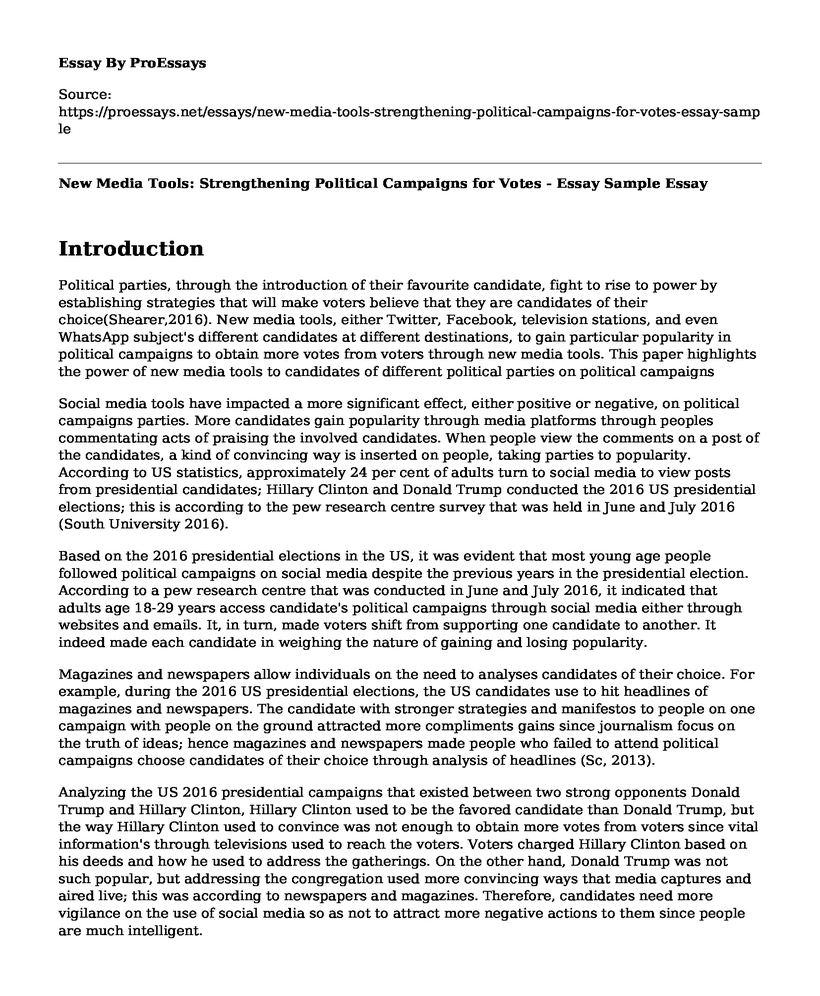Introduction
Political parties, through the introduction of their favourite candidate, fight to rise to power by establishing strategies that will make voters believe that they are candidates of their choice(Shearer,2016). New media tools, either Twitter, Facebook, television stations, and even WhatsApp subject's different candidates at different destinations, to gain particular popularity in political campaigns to obtain more votes from voters through new media tools. This paper highlights the power of new media tools to candidates of different political parties on political campaigns
Social media tools have impacted a more significant effect, either positive or negative, on political campaigns parties. More candidates gain popularity through media platforms through peoples commentating acts of praising the involved candidates. When people view the comments on a post of the candidates, a kind of convincing way is inserted on people, taking parties to popularity. According to US statistics, approximately 24 per cent of adults turn to social media to view posts from presidential candidates; Hillary Clinton and Donald Trump conducted the 2016 US presidential elections; this is according to the pew research centre survey that was held in June and July 2016 (South University 2016).
Based on the 2016 presidential elections in the US, it was evident that most young age people followed political campaigns on social media despite the previous years in the presidential election. According to a pew research centre that was conducted in June and July 2016, it indicated that adults age 18-29 years access candidate's political campaigns through social media either through websites and emails. It, in turn, made voters shift from supporting one candidate to another. It indeed made each candidate in weighing the nature of gaining and losing popularity.
Magazines and newspapers allow individuals on the need to analyses candidates of their choice. For example, during the 2016 US presidential elections, the US candidates use to hit headlines of magazines and newspapers. The candidate with stronger strategies and manifestos to people on one campaign with people on the ground attracted more compliments gains since journalism focus on the truth of ideas; hence magazines and newspapers made people who failed to attend political campaigns choose candidates of their choice through analysis of headlines (Sc, 2013).
Analyzing the US 2016 presidential campaigns that existed between two strong opponents Donald Trump and Hillary Clinton, Hillary Clinton used to be the favored candidate than Donald Trump, but the way Hillary Clinton used to convince was not enough to obtain more votes from voters since vital information's through televisions used to reach the voters. Voters charged Hillary Clinton based on his deeds and how he used to address the gatherings. On the other hand, Donald Trump was not such popular, but addressing the congregation used more convincing ways that media captures and aired live; this was according to newspapers and magazines. Therefore, candidates need more vigilance on the use of social media so as not to attract more negative actions to them since people are much intelligent.
Challenges Involved In The Use Of Social Media Tools By Political Parties In Political Campaigns
However, the use of social media is characterized by merits and demerits .new media tools tend to limit some people since not all people can make the use of social media say they may not be incapability to purchase televisions access smartphones and use internet(Zimmer,2011) .social media only supports the much privileged that is those who can afford hence new media tools a times not suitable for political campaigns by political parties at point.
Conclusion
In conclusion, political parties during political campaigns should maintain balancing criteria so that both the privileged and less privileged people get information about their communications, either face to face interactions with people or use of social media. This will allow voters to choose the right leaders based on their manifestos and not being bribed to vote for someone.
References
Sc, C. (2013). Using Social Media in Political Campaigns. Retrieved from: https://www.newmediacampaigns.com/page/using-social-media-in-political-campaigns
Shearer, E. (2016). Candidates' social media outpaces their websites and emails as an online campaign news source. Retrieved from: https://www.pewresearch.org/fact-tank/2016/07/20/candidates-social-media-outpaces-their-websites-and-emails-as-an-online-campaign-news-source/
South University. (2016). Political Campaigns and Social Media - Tweeting Their Way into Office. Retrieved from: https://www.southuniversity.edu/news-and-blogs/2016/08/political-campaigns-and-social-media-tweeting-their-way-into-office-106986
Zimmer, C. (2011). Campaigns and elections. Retrieved from: https://www.campaignsandelections.com/campaign-insider/texting-to-win
Cite this page
New Media Tools: Strengthening Political Campaigns for Votes - Essay Sample. (2023, Apr 04). Retrieved from https://proessays.net/essays/new-media-tools-strengthening-political-campaigns-for-votes-essay-sample
If you are the original author of this essay and no longer wish to have it published on the ProEssays website, please click below to request its removal:
- Assignment Example on National Institute of Justice
- Research Paper on Music in American Culture
- Essay Sample on Social Media Crime
- Essay Example on Rochester: Protecting Historical Buildings & Landscapes
- Modernization of Tonnies, Durkheim, Weber, And Marx: Assignment Example
- Essay Example on Nationalism: A Political and Emotional Expression of Identity.
- Exploring Japanese Film: Kobayashi, Fires on the Plain, 24 Eyes - Essay Sample







